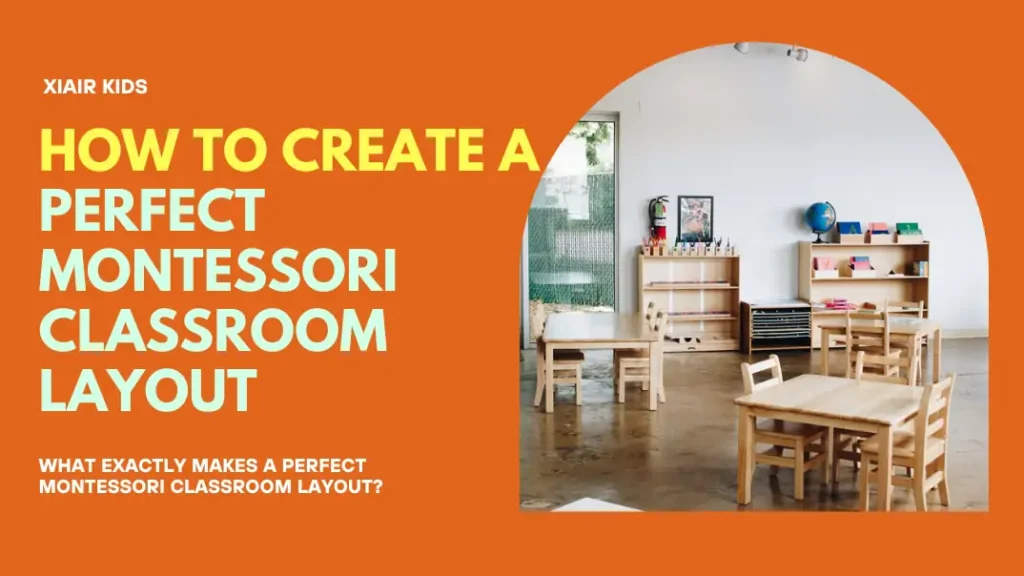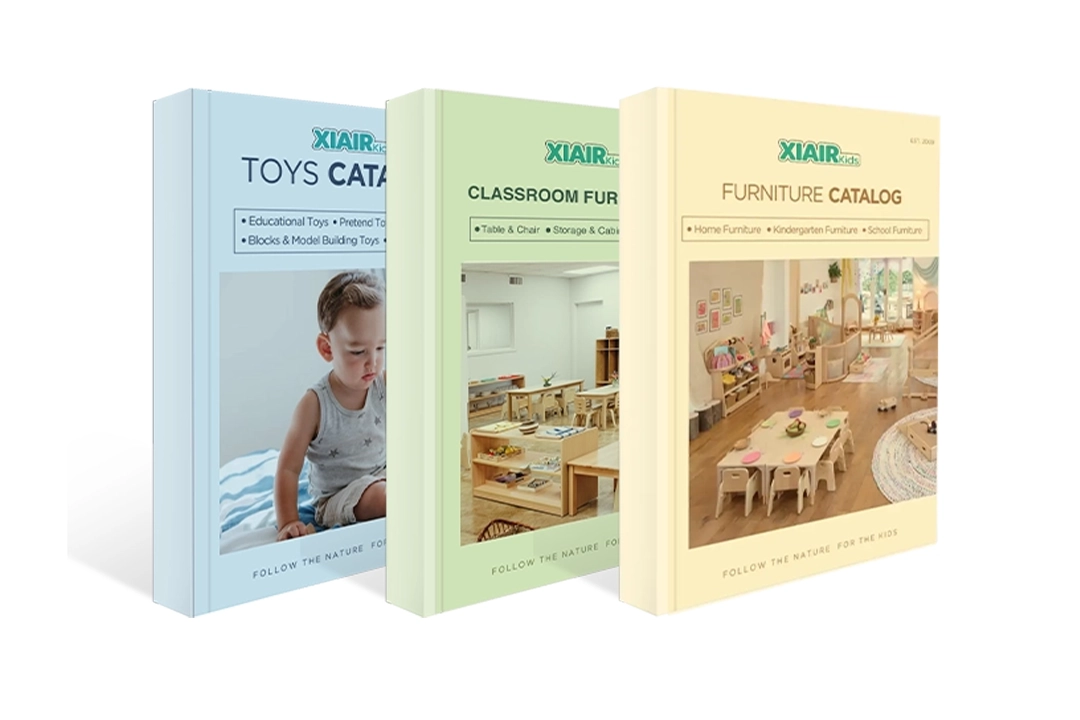Creating the ideal Montessori classroom layout can be a challenging task. It requires careful planning to ensure the space is conducive to learning and aligns with Montessori principles. But what exactly makes a perfect Montessori classroom layout? Many educators and parents are drawn to Montessori education because of its focus on fostering independence, creativity, and a love of learning. The classroom environment plays a crucial role in achieving these goals, as it is meticulously designed to support the developmental needs of each child.
A well-designed Montessori classroom layout is carefully crafted to promote independence, creativity, and a love of learning. It includes well-defined areas for various activities, uses natural light, and incorporates child-sized furniture and Montessori learning materials.
The Montessori method emphasizes the importance of a prepared environment, encouraging exploration and self-directed learning. The classroom layout must be intentional, allowing children to choose their activities while ensuring that each element within the space serves a specific educational purpose. Understanding the core principles behind Montessori classroom design can help you create an environment that fosters children’s academic, social, and emotional growth.
Read on to discover the key characteristics of a Montessori classroom layout and how to implement them in your space.
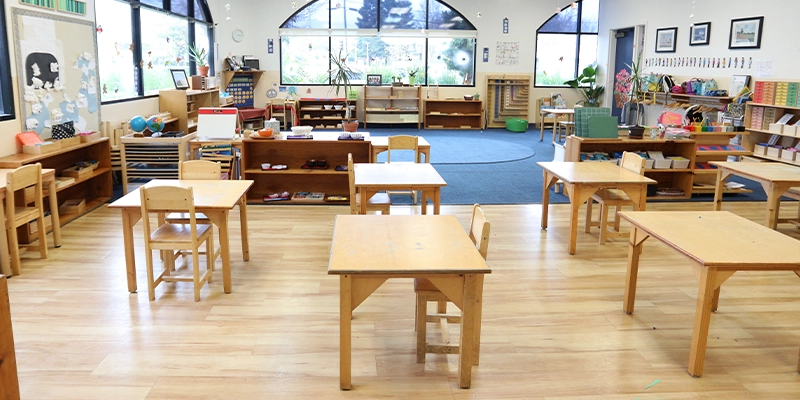
Before diving into the specific steps of setting up a Montessori classroom layout, it is essential to understand the key principles that guide every design choice.
Key Principles Behind a Montessori Classroom Layout
The Montessori classroom layout is deeply rooted in the educational philosophy developed by Dr. Maria Montessori. Every aspect of the layout—from furniture arrangement to material selection—is purposefully designed to foster independence, curiosity, and a love of learning.
One of the core principles is child-centered design. In a Montessori classroom layout, everything must be scaled to a child’s size and developmental stage. Low shelves, small chairs, and reachable materials empower children to explore and engage with their environment freely, without constant adult intervention.
Another critical concept is order and accessibility. A Montessori classroom layout ensures that every item has a designated place. This sense of order helps children develop internal organization skills, promotes self-discipline, and reduces distractions. When children can easily find and return materials on their own, they build responsibility and confidence.
Freedom within limits is another foundational idea. The Montessori classroom layout encourages free movement and independent choice, but within a thoughtfully prepared environment. Defined learning areas and clear pathways ensure that while children have freedom, the space still supports purposeful activity and focused concentration.
Lastly, the Montessori approach values connection with nature. Natural lighting, soft colors, wooden materials, and even indoor plants are standard features of a well-designed Montessori classroom layout. These elements create a calm and inviting atmosphere that nurtures emotional well-being and cognitive development.
Understanding these principles provides a strong foundation for creating a Montessori classroom layout that truly supports children’s holistic development.
Дизайн классной комнаты
A well-designed classroom not only looks aesthetically pleasing but also functions efficiently. Each element, from the furniture to the decorations, should serve a purpose and contribute to the overall learning experience. Flexible spaces that can be easily rearranged allow for various teaching methods and learning activities, adapting to the needs of students.
The overall layout should be uncluttered and organized, promoting a sense of tranquility and focus. This environment helps children feel secure and encourages them to explore and learn independently. Incorporating elements of nature, such as plants and natural light, can also enhance the classroom’s atmosphere, making it more inviting and comfortable.
Critical Elements of Montessori Classroom Design
- Natural light and ventilation: Ensuring a bright and airy atmosphere helps children feel more connected to the environment and improves their mood and concentration.
- Child-sized furniture: Furniture should be proportional to the children’s sizes to promote comfort and accessibility, allowing them to move and interact with their environment effortlessly.
- Defined learning areas: Marked spaces for different subjects and activities help children transition smoothly between tasks and understand the purpose of each location.
Consider the flow of movement within the classroom. Children should be able to move freely between different areas without feeling cramped or restricted. This fluidity supports their natural curiosity and desire to explore. The design should also include quiet areas where children can retreat for individual work or rest, supporting their need for social interaction and solitude.
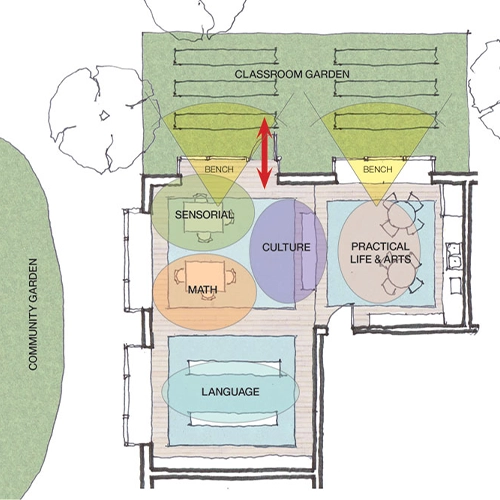
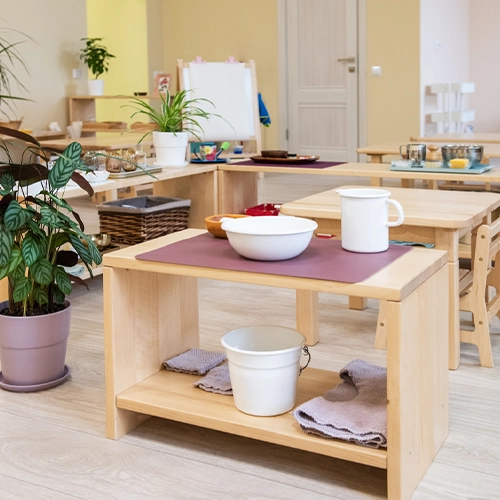
Montessori Learning Materials
Montessori learning materials are essential for a perfect classroom layout. These materials are designed to be self-correcting and encourage independent learning. They should be accessible to children, displayed on low shelves, and organized by subject area. Each material should have its place, promoting a sense of order.
The uniqueness of Montessori materials lies in their ability to teach complex concepts in a tangible way. For example, math materials often involve physical objects that children can manipulate to help them understand abstract concepts. This hands-on approach makes learning more engaging and aids in better knowledge retention. The materials are also designed to grow with the child, offering increasing levels of difficulty and complexity.
- Practical Life Materials: These materials teach everyday skills, such as pouring, spooning, and cleaning, promoting motor skills, concentration, and independence.
- Sensorial Materials: Sensorial materials refine the senses, helping children understand concepts such as size, shape, color, texture, sound, and smell.
- Language Materials: Language materials support reading, writing, and communication by utilizing tools such as movable alphabets and sandpaper letters.
- Mathematics Materials: Math materials make abstract concepts tangible, covering concepts such as counting, addition, subtraction, and more, using tools like number rods and bead chains.
- Культурные материалы: These materials promote global awareness, encompassing geography, history, science, and the arts through the use of maps, globes, and puzzles.
- Art and Music Materials: Art and music materials foster creativity through the use of paints, clay, musical instruments, and rhythm activities.
- Science Materials: Science materials introduce basic concepts in biology, physics, and earth sciences, encouraging exploration and discovery.
- Movement Materials: Movement materials, including balance beams, climbing structures, and yoga mats, support physical development.
- Social and Emotional Learning Materials: SEL materials help develop interpersonal skills and emotional regulation through the use of emotion cards and cooperative games.
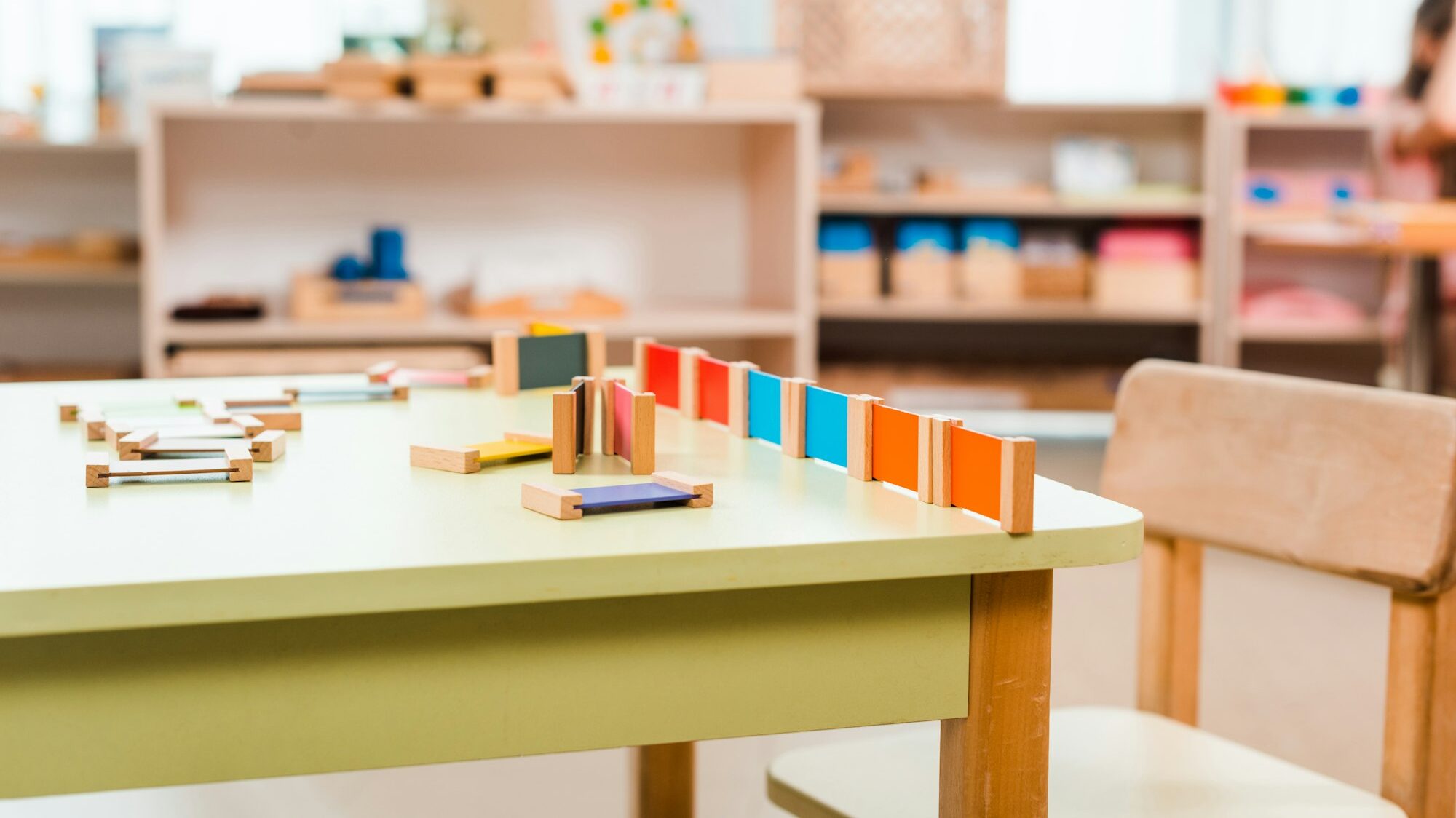
The Teacher as “Guide”
In a Montessori classroom, the teacher is a guide rather than a traditional instructor. This role influences the classroom layout. The teacher should have ample space to move around and observe children. The design should support independent work, with areas where children can work alone or in small groups.
Teachers in a Montessori classroom need to have a clear view of all students. This visibility allows them to observe and intervene when necessary without being intrusive. The furniture arrangement should facilitate this unobtrusive observation, enabling teachers to step in only when their guidance is genuinely needed.
The teacher’s desk should be minimal and placed in a less prominent location. This setup reinforces the idea that the classroom is a shared space focused on the children’s activities. The teacher’s role is to facilitate rather than dominate the learning process, guiding children towards discovering their potential.
Multi-Age Groupings
Montessori classrooms often include multi-age groupings. This diversity promotes peer learning and social development. The classroom layout should accommodate various age groups, with materials and activities tailored to different developmental stages.
Older children can mentor younger ones, sharing their knowledge and reinforcing the younger ones’ learning. This dynamic fosters a collaborative and supportive learning environment, where children learn from one another and the teacher.
Incorporate elements that celebrate the achievements of all age groups. Displaying the work of children of various ages can inspire and motivate others, creating an environment where success is shared and celebrated.
A Caring Community
Creating a caring community is at the heart of the Montessori philosophy. The classroom layout should facilitate social interaction and a sense of belonging. Include areas where children can gather for group activities, discussions, and celebrations.
The classroom should be a place where children feel safe and valued. This sense of security is essential for effective learning. Incorporating elements that promote socialization, such as group seating areas and cozy corners, helps build a strong classroom community.
Include visual elements that reflect the diversity and interests of the classroom community. Photographs, art, and cultural artifacts can make the space more personalized and inclusive. These elements also provide opportunities for discussions and learning about different cultures and experiences.
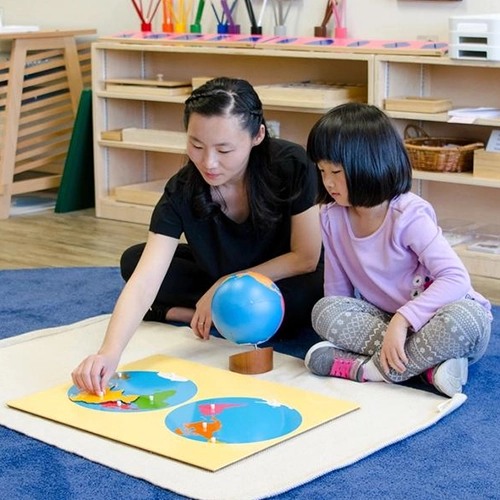
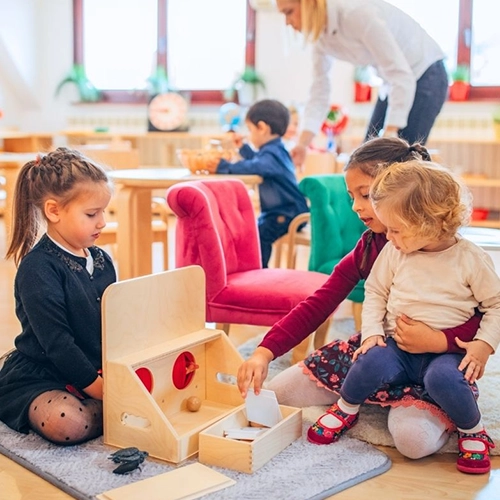
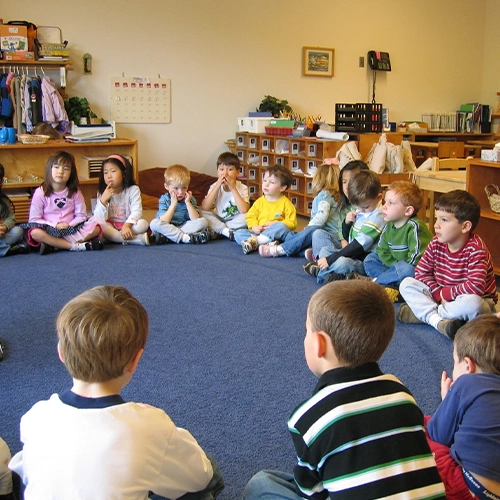
A perfect Montessori classroom layout supports independent learning, fosters a sense of community, and caters to the developmental needs of children. Thoughtful design and organization are vital to creating a practical and inviting learning environment. Considering the essential elements discussed above, you can make a Montessori classroom that enhances the educational experience. The proper layout supports academic growth and nurtures social and emotional development, preparing children for lifelong learning and success.
What are the Benefits of a Montessori Classroom Layout?
The Montessori classroom layout enhances learning by creating an environment that fosters independence, creativity, and concentration. But what are the specific benefits of this layout?
Create a Designated Area for Each Activity
A Montessori classroom layout includes specific areas for different activities, such as reading, practical life, and art. This organization helps children know where to find materials and activities, promoting independence and responsibility. Having designated areas allows children to focus on one task at a time, reducing distractions and enhancing their learning experience.
Designated areas also help create a structured environment where children can engage in purposeful work. Each location is thoughtfully arranged to encourage exploration and discovery. For instance, the practical life area might include pouring, spooning, and cleaning materials, while the reading corner offers a cozy space with various books. This precise segmentation not only aids in learning but also helps children in developing organizational skills and a sense of order.
Now that we’ve discussed the importance of zoning, let’s explore what specific learning areas are usually included in a Montessori classroom layout.
Creating Learning Zones in Your Montessori Classroom Layout
A well-organized Montessori classroom layout separates the space into different areas, each dedicated to a specific type of learning. No matter if you’re working on a Montessori preschool classroom layout or designing a Montessori elementary classroom layout, the idea of clear, calm zones stays the same.
Here are the main zones you should plan for in your Montessori classroom layout:
- Practical Life Area
This space includes activities that teach daily living skills, like pouring, sweeping, and buttoning. Materials here often include child-sized pitchers, cleaning tools, and dressing frames. It’s a key part of any Montessori primary classroom layout and helps children build independence and concentration.
- Sensorial Area
A must-have in every layout of a Montessori classroom, this area features materials that help children refine their senses, such as texture boards, color tablets, and sound cylinders.
- Language Area
This zone supports early reading, writing, and communication. Simple materials like sandpaper letters, movable alphabets, and beginner readers fit well here. Whether you’re setting up a Montessori kindergarten classroom layout or a first-grade Montessori classroom layout, the language area should feel cozy and inviting.
- Math Area
Hands-on materials for counting, addition, subtraction, and basic geometry belong here. Bead chains, number rods, and golden beads are common examples. A strong math area is part of a well-rounded Montessori classroom layout elementary plan.
- Cultural Area
Introduce children to geography, science, art, and history through hands-on materials like globes, puzzle maps, and science experiment kits. No matter if it’s a Montessori toddler classroom layout or a Montessori preschool classroom layout, a small cultural section can spark considerable curiosity.
- Тихий уголок для чтения
In any Montessori classroom layout, a cozy nook with soft lighting, a few floor cushions, and simple bookshelves encourages a love of reading.
Example Learning Zone Setup for Different Ages
| Возрастная группа | Key Learning Zones |
|---|---|
| Infant/Toddler | Practical Life, Sensorial Exploration, Soft Movement Areas |
| Primary (3-6 years) | Full Zones: Practical Life, Sensorial, Language, Math, Cultural |
| Lower Elementary | Expanded Zones: Advanced Math, Science Experiments, Research Areas |
| Upper Elementary | Project-Based Work Areas, Collaborative Learning Spaces |
Benefits of Designated Areas
- Promotes Focus: Children can concentrate on one activity at a time without being distracted by other materials.
- Encourages Responsibility: Knowing where materials belong fosters a sense of responsibility and care for the environment.
- Facilitates Learning: Defined spaces make navigating and engaging with their environment easier for children.
Tips for Setting Up Zones
- Keep pathways clear to allow free movement.
- Make each zone easy for children to access and use independently.
- Use low shelves or small rugs to visually separate areas without building walls.
If you’re planning the layout of Montessori classroom spaces for different age groups, remember that flexibility is key. As children grow, the classroom should be easy to adjust to meet their changing needs.
Use Child-Sized Furniture and Materials
Using child-sized furniture and materials is a cornerstone of the Montessori classroom layout. This approach ensures that everything is accessible to children, empowering them to take charge of their learning environment. Child-sized tables, chairs, and shelves allow children to move freely and choose activities independently, fostering a sense of ownership and confidence.
Children who can easily reach and use materials are more likely to engage in activities and develop fine motor skills. This accessibility also supports the Montessori principle of independence, allowing children to perform tasks without constant adult assistance. Moreover, child-sized furniture is safer and more comfortable for children, reducing the risk of accidents and enhancing their overall well-being.
Advantages of Child-Sized Furniture
- Empowers Children: Enables children to access and use materials, fostering their independence and self-reliance.
- Enhances Engagement: Children are more likely to participate in activities within their reach.
- Improves Safety: Appropriately sized furniture reduces the risk of falls and other accidents.
Furniture choices play a huge role in shaping the Montessori classroom layout. Picking the right pieces helps create a space that encourages independence and focus.
Essential Furniture for an Effective Montessori Classroom Layout
Setting up the right furniture is key to designing a supportive Montessori classroom layout. Whether you are working on a Montessori preschool classroom layout, a Montessori toddler classroom layout, or even planning a Montessori elementary classroom layout, the basics stay the same: everything should be child-friendly, accessible, and simple.
Here are the essential furniture elements every Montessori space needs:
- Low Open Shelves
Low shelves are a must in any layout of a Montessori classroom. They allow children to easily choose and return materials, which builds independence from a young age. Whether you’re planning a Montessori primary classroom layout or a Montessori infant classroom layout, open shelving keeps the environment organized and calm.
- Child-Sized Tables and Chairs
In any Montessori school classroom layout, tables and chairs should fit the size of the children. Smaller furniture promotes good posture and allows easy movement, a significant part of creating a child-centered environment.
- Floor Mats
Mats give children personal space for floor activities. In smaller setups like a small toddler classroom layout Montessori, providing enough mats helps balance limited table space.
- Натуральные материалы
Wooden furniture and neutral colors are preferred across all types of Montessori layouts—from the Montessori kindergarten classroom layout to the first grade classroom layout, and Montessori designs. Natural elements help create a calming atmosphere.
- Accessible Storage Units
Proper storage is essential, especially when planning a Montessori classroom layout, for elementary, or looking for Montessori classroom layout ideas. Open cubbies, labeled baskets, and trays help children keep their environment tidy.
Furniture Essentials at Different Montessori Levels
| Montessori Level | Key Furniture Focus |
|---|---|
| Infant | Soft mats, low shelves, small baskets |
| Toddler | Low tables, open shelves, floor work mats |
| Primary (ages 3-6) | Various sized tables, reading nooks, practical life stations |
| Lower Elementary | Group tables, project spaces, organized shelf units |
| Upper Elementary | Work desks, collaborative spaces, advanced material shelves |
If you’re looking for Montessori classroom layout pictures or more real-life examples, platforms like Pinterest’s Montessori classroom layout boards can provide plenty of creative ideas.
But if you want to see real, professionally designed Montessori spaces, check out our project gallery featuring actual classrooms with thoughtful layouts and beautiful materials. Visit Our Montessori Classroom Projects to get even more Montessori classroom layout inspo!
Не просто мечтайте, а проектируйте! Давайте обсудим ваши индивидуальные потребности в мебели!
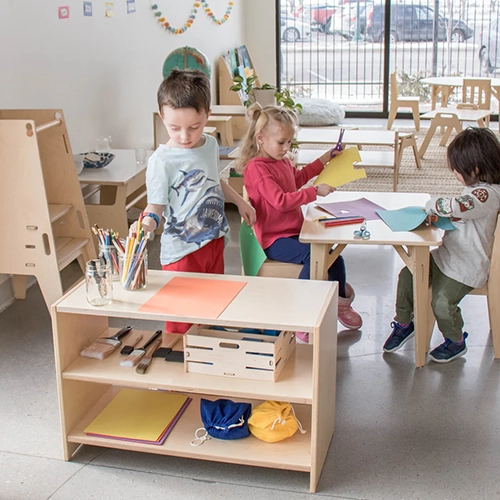
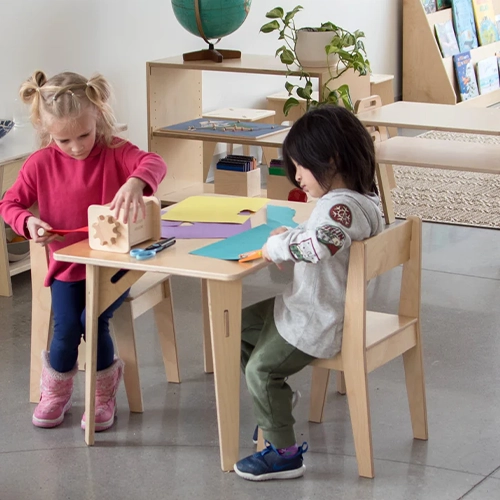
Keep the Classroom Organized and Clutter-Free
An organized and clutter-free environment is essential in a Montessori classroom layout. Clear, open spaces allow children to concentrate on their activities without distractions. Proper storage solutions and a minimalist approach help maintain order, making it easier for children to focus and learn effectively.
Clutter-free environments also contribute to a calm and peaceful atmosphere conducive to learning. Children can easily find and return materials when everything has its place, reducing frustration and encouraging independence. Furthermore, an organized space reflects the Montessori emphasis on order and discipline, helping children develop these essential life skills.
Incorporate Natural Elements and Sensory Experiences
Incorporating natural elements, such as plants, natural light, and sensory materials, enhances the Montessori classroom layout. These elements create a calm and inviting atmosphere, improving children’s mood and concentration. Sensory experiences with textures, colors, and sounds help develop children’s sensory perception and cognitive skills.
Nature-inspired classrooms foster a connection to the natural world, encouraging children to appreciate and care for their environment. Natural light has been shown to boost mood and productivity, while sensory materials engage children’s senses and support their cognitive development. Elements such as wooden toys, soft fabrics, and soothing colors create a warm and nurturing learning environment.
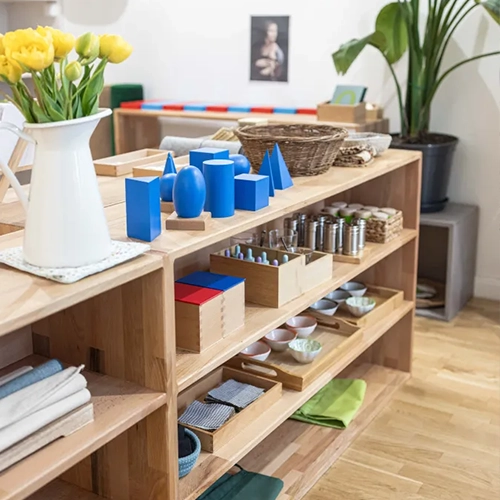
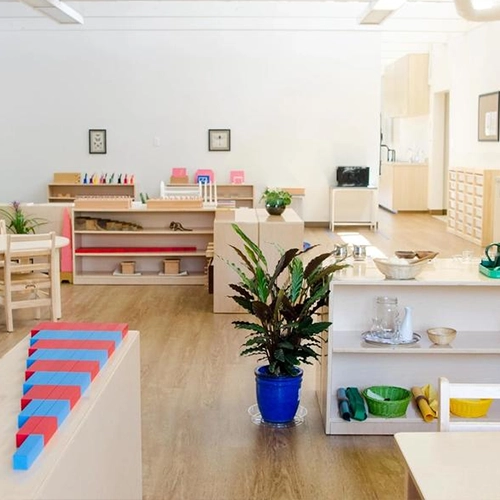
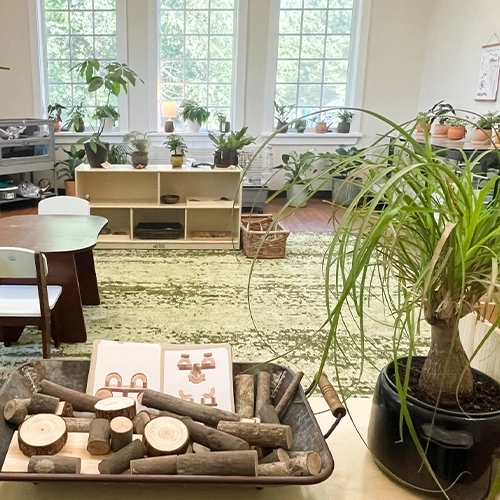
Allow for Flexibility and Freedom of Movement
Flexibility and freedom of movement are critical benefits of a Montessori classroom layout. The layout allows children to move freely and choose activities, fostering independence and self-motivation. Flexible seating arrangements and open spaces enable various learning activities, from individual work to group projects, accommodating different learning styles and needs.
This flexibility supports the Montessori emphasis on self-directed learning, allowing children to follow their interests and work independently. Open spaces encourage physical activity and exploration, which are crucial for young children’s development. Additionally, flexible layouts can adapt to different teaching methods and activities, making the classroom a dynamic and versatile learning environment.
A Montessori classroom layout provides numerous benefits, including designated activity areas, child-sized furniture, organized and clutter-free spaces, natural elements, and flexibility. These features create an environment that supports children’s independent, focused, and joyful learning. By embracing these principles, educators can create a space that enhances the educational experience. The proper layout supports academic growth and nurtures social and emotional development, preparing children for lifelong learning and success.
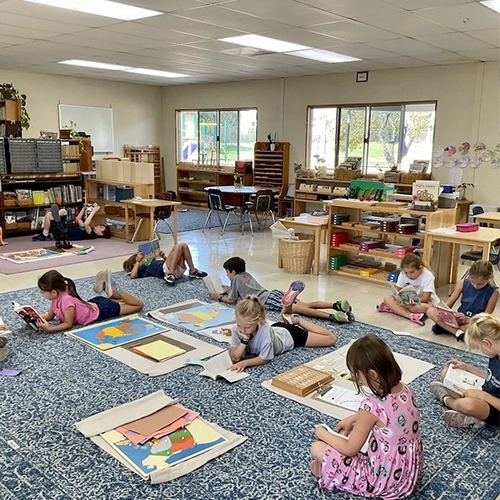
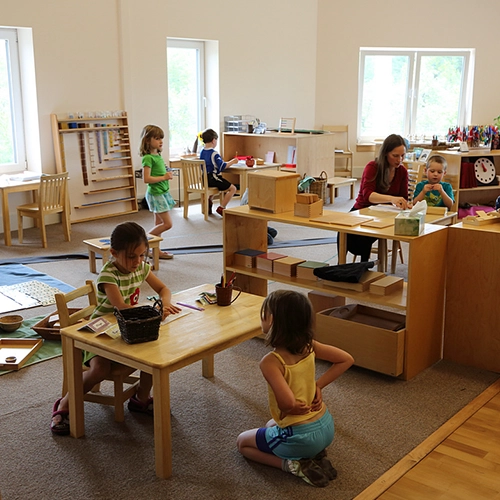
While planning a Montessori classroom layout, it’s just as important to know what mistakes to avoid as it is to know what to include.
Mistakes to Avoid When Designing a Montessori Classroom Layout
Designing a Montessori classroom layout takes careful thought. Even with the best intentions, it’s easy to make small mistakes that can affect how well the environment supports children’s learning and independence. Here are some common pitfalls to watch out for:
- Overcrowding the Space
One of the biggest mistakes is trying to fit too much into a limited area. Whether you’re setting up a Montessori preschool classroom layout or a Montessori toddler classroom layout, every item should have a clear purpose. Too much furniture or too many materials can overwhelm children and make the space feel chaotic. Always prioritize open floor areas for unrestricted movement.
- Ignoring Flow and Movement Paths
A good floor plan for a Montessori classroom layout considers how children move through the space. Furniture should be arranged to create natural walking paths without obstacles. Crowded or blocked walkways interrupt children’s concentration and independence.
- Not Updating the Layout as Children Grow
The needs of a Montessori primary classroom layout differ significantly from those of a Montessori elementary classroom layout. Failing to adjust the environment as children grow can limit their learning opportunities. Regularly reassess the setup to match children’s developing skills and interests.
- Placing Materials Out of Reach
In the layout of a Montessori classroom, everything should be accessible to children without needing adult help. Shelves that are too high or heavy furniture that children can’t move defeat the Montessori goal of promoting independence.
- Over-Decorating the Space
While a warm, inviting atmosphere is essential, overloading the walls with posters, bright colors, or too much visual clutter can be distracting. A simple, calm design helps children focus better, a key principle behind effective Montessori classroom layouts.
Quick Checklist to Avoid Common Layout Mistakes
| Mistake | How to Fix It |
|---|---|
| Overcrowded furniture | Remove non-essential items and create open areas |
| Blocked pathways | Keep all materials within the child’s reach |
| Static layout | Update zones and materials as children grow |
| High shelves | Keep all materials within child’s reach |
| Visual clutter | Stick to neutral tones and minimal decoration |
A well-planned Montessori classroom layout isn’t just about making a space look good — it plays a fundamental role in supporting children’s growth and development.
How Montessori Classroom Layout Supports Child Development
The Montessori classroom layout is carefully designed to nurture every part of a child’s development — from physical movement to emotional confidence and cognitive skills. When done right, the layout itself becomes a silent teacher in the classroom.
- Поощряет независимость
One of the main goals of any Montessori preschool classroom layout or Montessori primary classroom layout is to help children do things by themselves. Low shelves, child-sized furniture, and clearly labeled materials let kids choose, use, and put away work without adult help. This builds their self-confidence and decision-making skills early on.
- Fosters Focus and Concentration
A simple, uncluttered layout of a Montessori classroom helps children concentrate. When each area is clearly defined and materials are neatly arranged, children can stay focused longer. Whether it’s a small toddler classroom layout, a Montessori classroom layout, or a Montessori elementary classroom layout, a calm space always supports deeper learning.
- Способствует физическому развитию
Montessori classrooms encourage movement. With open floors and easy-to-navigate zones, children naturally develop better balance, coordination, and gross motor skills. In designs like the floor plan of a Montessori classroom layout, freedom of movement is built right into the environment.
- Supports Social Skills
Thoughtful layout planning, like providing space for small group activities or quiet one-on-one work, helps children practice social interactions. Even a Montessori kindergarten classroom layout can subtly guide children toward cooperation, sharing, and respectful communication.
- Stimulates Natural Curiosity
When materials are displayed beautifully and invitingly, children feel drawn to explore and learn. A well-thought-out classroom Montessori layout encourages children to ask questions, try new things, and develop a love of learning that lasts a lifetime.
How Layout Shapes Development
| Area of Growth | Layout Feature |
|---|---|
| Независимость | Low shelves, child-accessible materials |
| Фокус | Clear zones, simple decor |
| Physical Skills | Open movement paths |
| Социальные навыки | Group tables, small work areas |
| Любопытство | Well-organized, attractive material displays |
How to Create a Montessori Classroom?
Creating a Montessori classroom layout involves thoughtful planning and design to foster an environment that encourages independence, creativity, and a love for learning. Below are key aspects and ideas to help you design a perfect Montessori classroom layout.
Montessori Classroom Layout Philosophy
The Montessori classroom layout philosophy centers around creating an environment that promotes independence, exploration, and holistic development. The design is child-centered, ensuring that everything from furniture to learning materials is scaled to the size and needs of the children. This accessibility empowers children to choose activities independently and navigate their space freely, fostering a sense of ownership and confidence. An organized and orderly environment is essential, with each item having a designated place, reducing distractions and helping children focus on their tasks. Natural light and materials create a calm, inviting atmosphere that enhances learning and well-being.
Incorporating elements of nature, such as plants and natural materials, is also vital to the Montessori classroom layout. These elements make the space more inviting and teach children to appreciate and care for their environment. The design includes dedicated areas for sensory and practical life activities, allowing children to engage in hands-on learning that develops their motor skills and sensory perception. Flexibility and adaptability in the layout accommodate various teaching methods and learning styles, supporting a dynamic and engaging learning environment. Overall, the Montessori classroom layout philosophy aims to create a nurturing space that supports each child’s intellectual, emotional, and physical growth.
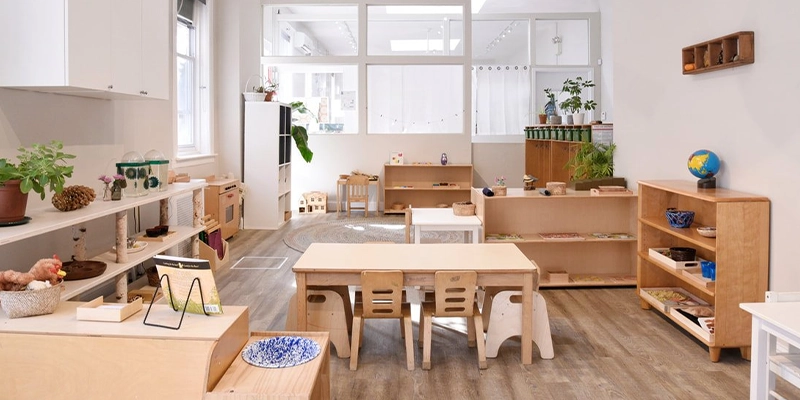
Montessori Classroom Design Ideas
Focus on Natural Light and Neutral Colors
Natural light plays a crucial role in the Montessori classroom layout. Bright, airy spaces enhance mood and concentration, making the learning environment more pleasant and effective. Neutral colors on walls and furniture create a calm and welcoming atmosphere, allowing the learning materials and children’s work to stand out without overwhelming the senses.
Natural light helps regulate children’s circadian rhythms, promoting better sleep and overall well-being. Combined with neutral colors, it creates a serene and focused environment that minimizes distractions and overstimulation. Using neutral tones for walls and furniture also allows the vibrant colors of Montessori materials to stand out, making them more attractive and engaging for children.
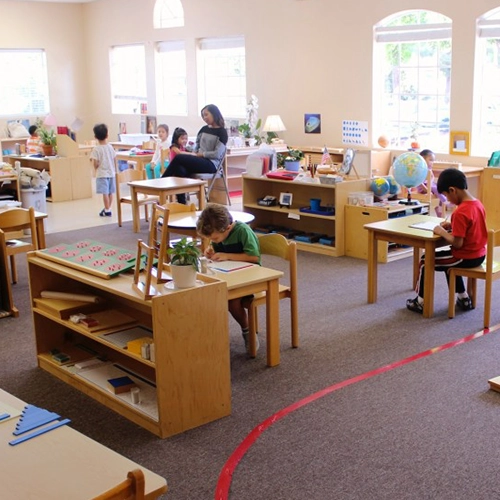
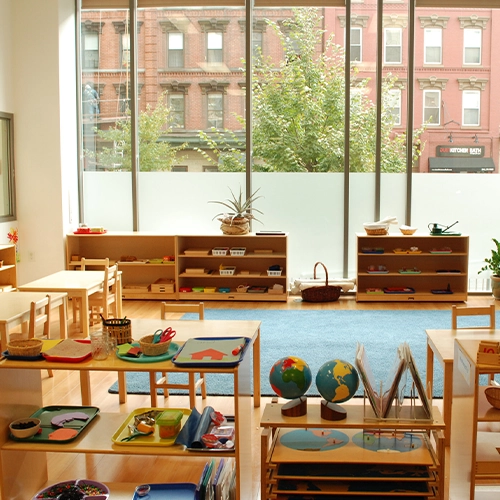
Incorporate Natural Materials and Plants
Using natural materials such as wood, cotton, and wool alongside plants brings a touch of nature into the classroom. This makes the space more inviting and teaches children to appreciate and care for their environment. Plants can improve air quality and provide opportunities for children to learn about biology and ecology through hands-on experiences.
Natural materials offer sensory benefits, providing different textures and warmth than synthetic materials. This connection to nature supports the Montessori philosophy of creating environments that nurture the whole child—physically, emotionally, and intellectually. Children can participate in caring for plants, learning responsibility, and the basics of plant biology.
Create a Sense of Order and Organization
An organized Montessori classroom layout is vital for fostering a productive learning environment. Each item should have a designated place, and materials should be arranged logically. This organization helps children understand the concept of order, reduces distractions, and makes it easier to focus on their activities. Clear, open spaces are essential to avoid clutter and create a sense of calm.
Children thrive in environments where there is predictability and order. When everything has a place and is returned after use, it teaches children responsibility and respect for their environment. Open shelves, labeled containers, and clearly defined activity areas help children navigate the classroom independently and confidently.

Provide Accessible and Engaging Learning Materials
Materials in a Montessori classroom should be easily accessible to children. Low shelves and appropriately sized furniture enable children to reach and return materials independently, fostering self-reliance. The learning materials should be engaging, self-correcting, and designed to develop specific skills, from practical life activities to complex cognitive tasks.
Accessible materials empower children to make choices about their learning. By selecting activities independently, children develop decision-making skills and intrinsic motivation. Self-correcting materials allow children to learn from their mistakes without constant adult intervention, promoting confidence and problem-solving skills.
Foster a Sense of Community and Collaboration
Creating spaces that encourage community and collaboration is vital to the Montessori classroom layout. Group seating areas, round tables, and cozy reading nooks allow children to collaborate, share ideas, and build social skills. These areas should be flexible, allowing for various group sizes and activities, from collaborative projects to group discussions.
Collaborative spaces teach children the importance of working together and respecting others’ ideas. These interactions build communication and teamwork skills essential for their future. Creating a community-focused environment helps children develop empathy and a sense of belonging.
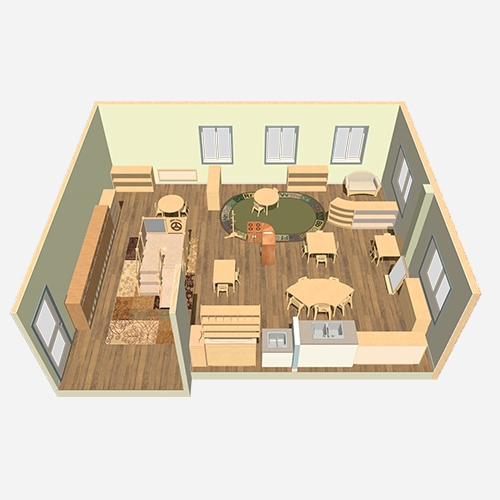


Designing a Montessori classroom layout requires attention to natural elements, organization, accessibility, and community-building. Focusing on these critical aspects can create a learning environment that supports Montessori philosophy and promotes children’s independent, engaged, and joyful learning. Through thoughtful design, educators can create a space that nurtures the whole child and prepares them for lifelong success.
Why Incorporate Montessori Classroom Layout?
Incorporating a Montessori classroom layout offers numerous benefits that enhance children’s learning experiences. The Montessori classroom layout fosters independence, creativity, and a love for learning. Children are encouraged to explore and engage with their surroundings by creating a child-centered, well-organized, and aesthetically pleasing environment.
The Montessori classroom layout uses child-sized furniture and accessible materials to promote autonomy. Low shelves and open spaces allow children to choose and return materials independently, fostering a sense of responsibility and confidence. Natural light and neutral colors create a calm, inviting atmosphere, enhancing concentration and well-being. Additionally, incorporating natural elements such as plants and wooden materials connects children to nature and promotes environmental awareness.
The emphasis on order and organization within the Montessori classroom layout helps reduce distractions, enabling children to focus better on their tasks. Each item has its designated place, teaching children the importance of order and helping them develop organizational skills. The flexible and adaptable layout accommodates various teaching methods and learning styles, supporting a dynamic and engaging learning environment.
Adopting a Montessori classroom layout nurtures children’s intellectual, emotional, and physical development, preparing them for future success and lifelong learning.
Montessori Classroom vs Traditional Classroom
The Montessori classroom layout significantly differs from traditional classroom settings in several vital ways. The Montessori layout emphasizes child-centered design, flexibility, and natural materials. At the same time, traditional classrooms often feature teacher-centered layouts, fixed structures, and a reliance on textbooks and worksheets. These differences highlight the unique advantages of the Montessori approach in promoting holistic development and self-directed learning.
In a Montessori classroom, children can choose their activities and learn at their own pace, fostering independence and deep engagement. Traditional classrooms typically follow a more rigid curriculum with teacher-led instructions, which can limit creativity and individual exploration. The role of the teacher in Montessori settings is to guide and facilitate rather than direct, creating a collaborative learning environment.
Montessori materials are designed to be self-correcting and hands-on, promoting active learning and problem-solving, while traditional classrooms often use less interactive learning tools. The Montessori layout encourages social interaction through mixed-age groupings, enhancing peer learning and cooperation. In contrast, traditional classrooms usually group students by age and may promote a more competitive atmosphere.
Overall, the Montessori classroom layout provides a nurturing, dynamic environment that supports independent learning, creativity, and holistic development, offering significant advantages over traditional classroom settings.
For a more detailed look at this section, please see our article comparing Montessori vs Traditional Schools.
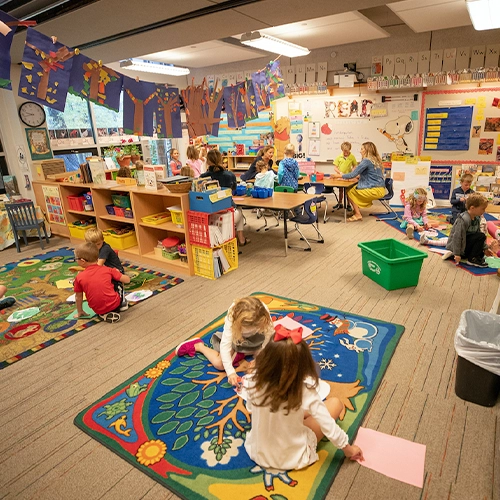
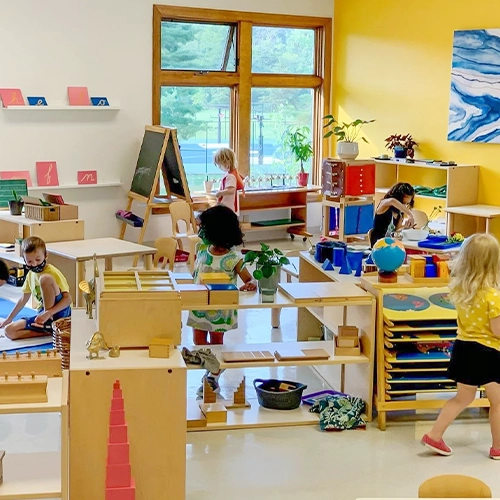
Заключение
A thoughtfully designed Montessori classroom layout does more than organize a space — it creates an environment where independence, focus, creativity, and community naturally thrive. Every detail, from low shelves to cozy reading corners and clear movement paths, plays a part in shaping a child’s daily experiences and long-term growth.
By understanding the key principles of Montessori design and carefully planning each learning zone, you can build a classroom that truly honors each child’s journey toward self-discovery. Whether you’re working on a small toddler space or a complete Montessori elementary classroom layout, the heart of the design remains the same: trust the child’s ability to learn, explore, and grow within a prepared and beautiful environment.
Ready to bring your vision to life? Start with thoughtful choices—and create a Montessori classroom layout that inspires every day.
Часто задаваемые вопросы
What is the typical layout of a Montessori classroom?
A typical Montessori classroom layout features open spaces, clearly defined learning zones, low shelves with accessible materials, and plenty of natural light. Whether in a Montessori preschool classroom layout or a Montessori elementary classroom layout, the environment is always calm, organized, and child-centered.
How do I create a small Montessori classroom layout?
If you’re working with limited space, focus on just a few essential learning zones and keep materials to a minimum. Use multi-functional furniture and maximize floor work areas. Look at a small toddler classroom layout Montessori ideas for inspiration on using compact spaces effectively.
What should I include in a Montessori toddler classroom layout?
A Montessori toddler classroom layout should have low shelves, simple practical life activities (like pouring and scooping), sensory materials, and cozy spaces for quiet play. Open areas for movement are also key at this stage.
How often should a Montessori classroom layout change?
The layout doesn’t need constant major changes, but it should evolve with the children. As they grow or new interests emerge, you can adjust material displays and rearrange zones. A flexible Montessori classroom layout, elementary, allows for easy updates without confusing the children.
Where can I find ideas for a Montessori classroom layout?
Great resources include browsing Pinterest Montessori classroom layout boards, checking Montessori classroom layout pictures online, or looking at real-world Montessori classroom layout sample designs shared by schools.
What’s the best way to plan the Montessori elementary classroom layout?
Start by understanding the specific needs of elementary-age children: more group projects, independent research, and collaborative work. When planning the Montessori elementary classroom layout, the plan should balance personal workspaces with areas for teamwork, plus access to advanced learning materials.
